
Synopsis
Much praised for its clearly written, easy-to-read/understand style, this text provides thorough, current, single-volume coverage of all Intel 80x86 microprocessors relative to their application in the PC, and is as much an introduction to the PC itself as to Intel chips. Coverage ranges from chip architecture to programming and memory and I/O interfacing--i.e., microprocessor chips, memory chips, I/0 devices, and the logic circuits needed to "glue" these parts together. Features 8 fully-documented programs using DEBUG (Ch. 5). All programs are supplied on accompanying disk (including Debug 32), and can run on any PC. Microcomputers and Microprocessors. Computer Codes, Programming, and Operating Systems. 80x86 Processor Architecture. Introduction to 80x86 Programming. 80x86 Programming Techniques. 80x86 Assembly Language Programming. Memory Chips and Memory Interfacing. Input/Output Techniques: Programmed I/O. Input/Output Techniques: Interrupts and DMA. Data Communications. Personal Computer Architecture and Bus Systems. For Technicians, Engineers, and field Service Engineers who need an introduction to the Intel microprocessors and microprocessor technology.
"synopsis" may belong to another edition of this title.
From the Back Cover
Written for introductory courses in microcomputers or microprocessors, this text's clarity and easy-to-follow writing style have been highly and consistently praised by reviewers and readers. Each chapter contains a chapter outline, learning objectives, a chapter overview, hierarchical design, self-review questions, self-test questions, and analysis and design questions-all of which enhance learning.
This new edition of The 80x86 Family. Design, Programming, and Interfacing has been extensively updated to include material on the newest processors, including the Pentium II and III, the Xeon, the Itanium, and AMD's Athlon. More than 65 new end-of-chapter questions and problems have been added, along with numerous new figures and tables. Also included in the text are suggestions for Internet and hands-on lab projects.
Included with each book is a CD, organized by chapter, that contains the assembly listings for all of the programs in the book. The disk also contains a copy of DEBUG32, enhanced software that allows full access to the 32-bit registers and addressing capabilities of 80x86 processors. DEBUG32 also can be used for debugging protected mode programs.
An Instructor's Manual (0-13-032833-2) containing answers and solutions to all of the end-of-chapter questions and problems is available free of charge to instructors who are using this book for a course.
"About this title" may belong to another edition of this title.
Other Popular Editions of the Same Title
Search results for The 80x86 Family: Design, Programming, and Interfacing...
The 80x86 Family: Design, Programming, and Interfacing (3rd Edition)
Seller: ThriftBooks-Dallas, Dallas, TX, U.S.A.
Hardcover. Condition: Good. No Jacket. Missing dust jacket; Pages can have notes/highlighting. Spine may show signs of wear. ~ ThriftBooks: Read More, Spend Less 2.8. Seller Inventory # G0130257117I3N01
The 80x86 Family: Design, Programming, and Interfacing (3rd Edition)
Seller: HPB-Red, Dallas, TX, U.S.A.
Hardcover. Condition: Good. Connecting readers with great books since 1972! Used textbooks may not include companion materials such as access codes, etc. May have some wear or writing/highlighting. We ship orders daily and Customer Service is our top priority! Seller Inventory # S_358212428

